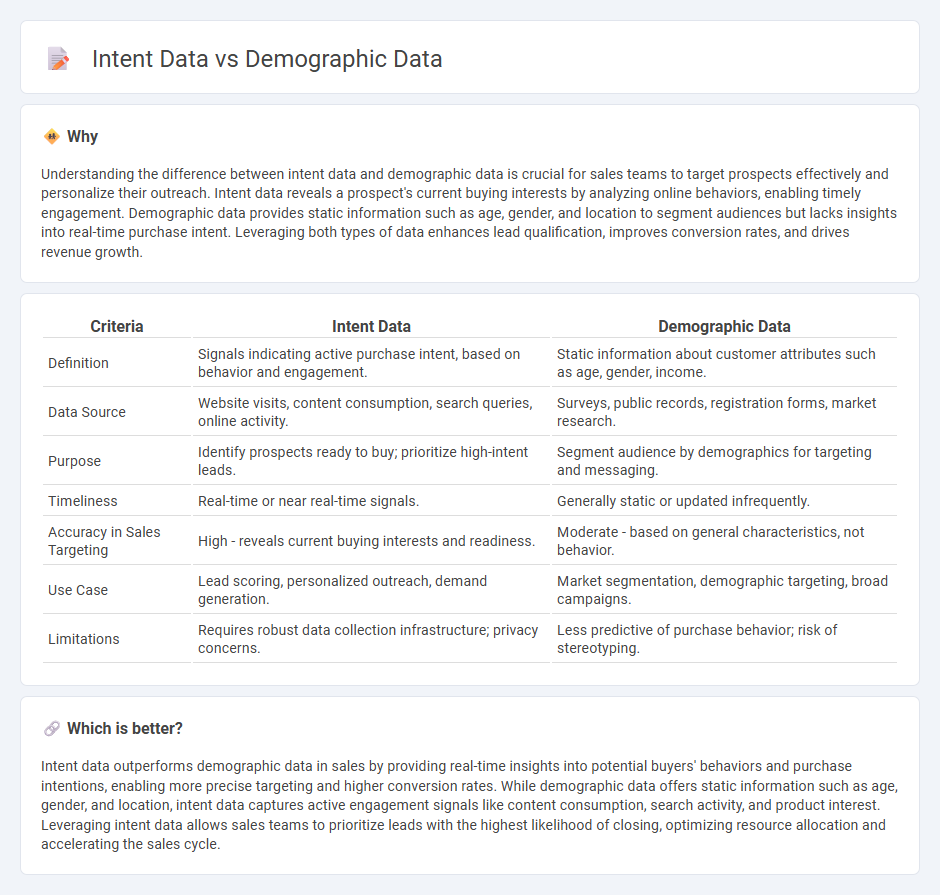
Intent data reveals prospect behavior and signals buying readiness by tracking online activities, while demographic data provides static, categorical information such as age, gender, and job title. Leveraging intent data enhances sales targeting accuracy and accelerates deal closure by identifying high-potential leads in real time. Explore how combining intent and demographic data can transform your sales strategy for maximum effectiveness.
Why it is important
Understanding the difference between intent data and demographic data is crucial for sales teams to target prospects effectively and personalize their outreach. Intent data reveals a prospect's current buying interests by analyzing online behaviors, enabling timely engagement. Demographic data provides static information such as age, gender, and location to segment audiences but lacks insights into real-time purchase intent. Leveraging both types of data enhances lead qualification, improves conversion rates, and drives revenue growth.
Comparison Table
| Criteria | Intent Data | Demographic Data |
|---|---|---|
| Definition | Signals indicating active purchase intent, based on behavior and engagement. | Static information about customer attributes such as age, gender, income. |
| Data Source | Website visits, content consumption, search queries, online activity. | Surveys, public records, registration forms, market research. |
| Purpose | Identify prospects ready to buy; prioritize high-intent leads. | Segment audience by demographics for targeting and messaging. |
| Timeliness | Real-time or near real-time signals. | Generally static or updated infrequently. |
| Accuracy in Sales Targeting | High - reveals current buying interests and readiness. | Moderate - based on general characteristics, not behavior. |
| Use Case | Lead scoring, personalized outreach, demand generation. | Market segmentation, demographic targeting, broad campaigns. |
| Limitations | Requires robust data collection infrastructure; privacy concerns. | Less predictive of purchase behavior; risk of stereotyping. |
Which is better?
Intent data outperforms demographic data in sales by providing real-time insights into potential buyers' behaviors and purchase intentions, enabling more precise targeting and higher conversion rates. While demographic data offers static information such as age, gender, and location, intent data captures active engagement signals like content consumption, search activity, and product interest. Leveraging intent data allows sales teams to prioritize leads with the highest likelihood of closing, optimizing resource allocation and accelerating the sales cycle.
Connection
Intent data reveals potential buyers' online behaviors and interests, while demographic data provides static attributes such as age, gender, location, and income. Combining these datasets enables sales teams to create highly targeted customer profiles, improving lead scoring accuracy and campaign personalization. This connection enhances conversion rates by aligning sales strategies with both who the prospects are and what they actively seek.
Key Terms
Age (Demographic Data)
Age, as a key demographic data point, provides businesses with foundational audience segmentation for targeted marketing strategies. While demographic data identifies age groups to tailor content, intent data reveals users' current interests and purchase readiness, offering deeper insights into behavior beyond age brackets. Explore how blending age demographics with intent data can enhance precision in customer engagement strategies.
Purchase Signals (Intent Data)
Purchase signals in intent data reveal real-time consumer behaviors such as online searches, product page visits, and cart additions, providing actionable insights into buying readiness. Unlike demographic data that offers static profiles based on age, gender, or location, intent data captures dynamic interest and purchase intent critical for targeted marketing campaigns. Explore how leveraging purchase signals can optimize conversion rates and drive sales growth.
Geographic Location (Demographic Data)
Geographic location, a key element of demographic data, provides insights into customers' physical regions, enabling targeted marketing strategies based on regional preferences and behaviors. Unlike intent data, which reveals user motivations and purchase intent, geographic data helps businesses tailor offerings to local market trends, climate, and cultural factors. Explore how leveraging geographic demographic data can enhance your marketing precision and customer engagement.
Source and External Links
What you can learn about your community from demographics - Demographic data includes information on population size, growth, and detailed social, economic, and housing characteristics, which helps understand community trends and guide decision making.
Demography - Wikipedia - Demography studies population processes and characteristics, including labor market impacts and patient demographics, offering insights into population aging, immigration, and organizational turnover.
What Are Demographics? (Definition and Examples) | Indeed.com - Demographics are population characteristics categorized by age, income, race, education, and location, used by businesses and governments for marketing, policy-making, and economic analysis.
 dowidth.com
dowidth.com